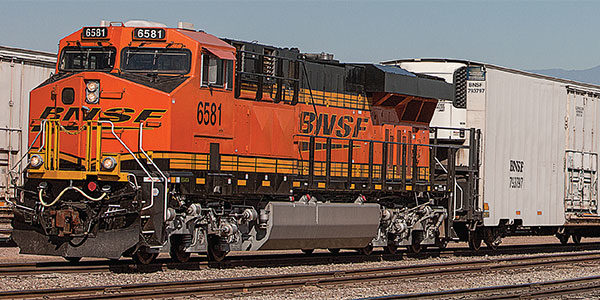A new pairing for refrigerated transport

In an episode of the TV series "Mad Men," a chronicle of the 1960s New York advertising world through the eyes of a fictitious agency, the daughter of one of the partners pleads with him to invest in a wondrous idea called "refrigerated transportation." Imagine a world, she tells him in early 1968, where fresh and frozen foods can be transported door to door by trucks over thousands of miles without spoiling.
If ever in this business there were a case of art imitating life, this is it. With the advent of superior refrigeration systems and more powerful and efficient diesel engines, long-haul refrigerated, or reefer, trucking took off in the early 1970s. It created new choices for consumers, new markets for shippers, and a new industry—and virtual monopoly—for carriers. It has been that way for nearly a half century.
But the last few years have shown that railroads are more than willing to jump into the truckers' traditional sandbox. The rails, knowing truck shippers are concerned about volatile fuel costs, increased regulatory pressure, and capacity availability, among other things, have aggressively pushed into domestic intermodal services; this has resulted in the conversion of millions of trailers from the highways to the tracks. In the past year or so, rails have shortened their intermodal lengths of haul, encroaching even further into what has been truckers' sovereign territory.
Now, rails are eyeing a bigger slice of transport's cold chain, a business they've been involved in for years, albeit in a modest way. By using rail intermodal for most of the total move, operators are looking to underprice end-to-end truck transport by 10 to 15 percent on produce shipments moving from farm to market. How well the rails and their partners execute could, over time, reshape a market still controlled by truck; by some estimates, only 2 percent of U.S. long-haul produce traffic moves via intermodal.
Sometime in May, a service will launch that its backers said will put a new spin on the reefer transport tale. Dubbed "TransCold Express," the service calls for BNSF Railway to operate dedicated weekly trains linking specially designed "food parks" in Wilmington, Ill., about 60 miles southwest of Chicago, with Selma, Calif., a town 20 miles south of Fresno that's known as the world's "raisin capital." Heading west, a BNSF train will pull refrigerated and frozen food products such as meats and cheeses in 50 72-foot specialized boxcars, each one capable of holding the equivalent of four trailerloads of palletized cargo. Coming east, another BNSF train of identical size will carry produce shipments from California's Central Valley to the Midwest. Each train will initially operate on Wednesday and take four days to traverse the 2,220 miles between hubs.
A DIFFERENT DRUMMER
A key distinction between this and traditional intermodal services is that it will operate as a rail-truck hybrid instead of incorporating a wider-reaching dray, according to Randy McKay, CEO of McKay TransCold, an Edina, Minn.-based company largely responsible for developing the project. In a typical intermodal move, truck draymen move goods to and from the rail ramps. However, dray equipment covers only about 200 miles before drivers must return to origin, McKay said. With the new service, drivers can drop off loads at destination, pick up another load, and head off without returning to base, he said. McKay said the service will increase supply chain coverage and flexibility beyond what is available through today's intermodal offerings.
"By loading four truckloads of cargo onto one boxcar and then cross-docking those goods to standard reefer trailers, we can run those trucks as if they are regular refrigerated trucks," McKay said in an e-mail to DC Velocity. "They don't need to deadhead back to our yard."
From the Selma railhead, for example, trucks will carry goods as far south as San Diego and as far north as the Bay Area, McKay said. There are no plans to extend service into the Pacific Northwest, McKay said.
Eastbound, goods can be trucked up to 500 miles to points in the Midwest and into the East and South, he said.
About half of the fleet will consist of dedicated contract carriage, with the remainder coming from the spot market, McKay said. He declined to identify the name of the fleet contractor. Private fleets operated by beneficial cargo owners may also be involved, meaning a retailer's trucks can meet the freight at the intermodal hub instead of having McKay's trucks deliver the loads to the retailer's door.
The Wilmington distribution hub, known as RidgePort, is being developed by Ridge Property Trust, a Chicago-based private real estate investment trust (REIT). Van-G Logistics, located in Fowler, Calif., 11 miles from Fresno, will run the Selma facility. McKay said the goal is to offer a full-service operation at both facilities.
LONG LEADTIME
McKay said in mid-January that several anchor customers were "ready to sign contracts," but that the company wanted to wait until the launch date grew nearer before it committed.
There are risks that will remain once the service starts. Volume density is critical to the success of any bidirectional operation. Yet there has always been a pronounced directional imbalance favoring goods from the West Coast. McKay executives acknowledge they will have to make a strong sales push on the westbound leg to narrow the gap.
Though a multitude of produce comes out of California's verdant Central Valley, the pipeline generally runs dry for about two months out of the year. McKay executives said they hope to pick up the slack by booking other types of temperature-sensitive goods.
C. Thomas Barnes, president of Con-way Multimodal, a mode-agnostic unit of trucking and logistics giant Con-way Inc., said the nascent service will get a boost by using BNSF's Los Angeles-Chicago lane. Barnes said the trains on the corridor run "like clockwork" with rapid velocity and short dwell times, both important attributes in hauling perishables. Truckers involved in the operation should also gain efficiencies through better equipment utilization, a result of driving longer distances than the typical dray, he said.
Barnes said the key would be the speed at which cargo is transloaded at destination from the boxcars to the trailers. Transloading can be time-consuming and labor-intensive, adding to the cost and risk of product spoilage, he said.
The McKay service is not the only rail initiative slated to start this year that focuses on the produce market. Also this spring, a company called Tiger Cool Express LLC, founded by intermodal veterans Ted Prince, Tom Finkbiner, and Tom Shurstad, is expected to get rolling. Like McKay TransCold, the Tiger Cool folks spent several years trying to get growers, retailers, railroads, and financiers seriously interested in a service that, up until now, has been off the beaten path.
Little wonder. Trucks come with higher costs relative to rail. However, trucks promise faster, direct transit times and fewer hand-offs, must-haves for perishables shippers and their customers. As such, no one expects the produce business to radically flip to intermodal or boxcar any time soon.
McKay said his goal is not necessarily to take share from truckers but to offer an interesting alternative to stakeholders in the reefer supply chain. Those stakeholders, he said, include truckers.
The service is designed to "give trucking companies, shippers, and others options with added service offerings," he said.

Copyright ©2024. All Rights ReservedDesign, CMS, Hosting & Web Development :: ePublishing